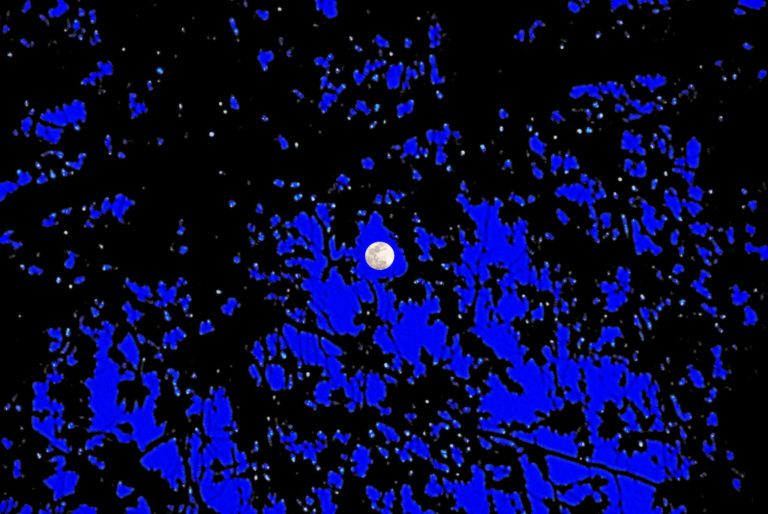Dark settles in, and the spring forest just ahead of you lights up with a magical swarm, moving together like an early morning fog, in and out of the trees that shade you. But this is no ordinary white, misty fog. No. It’s a steady, shining body of . . . blue.
What is it? Well, the better question is, What are they?
If you’ve happened upon these phantom-like fliers unaware, then you may suspect that you’ve stepped onto a haunt for the most peculiar of dead spirits. But rest assured: they’re only insects.
In fact, they’re insects you’ve probably heard of before: fireflies. Lightning bugs.
These “blue ghost” fireflies (or phausis reticulate) — one of the lesser-known firefly species — are native to the eastern and central United States, especially the southern Appalachian Mountains of Tennessee and the Carolinas. But only in very small pockets.
When they mate during the spring season, the males emit a bright glow to attract the females. However, unlike other firefly species, their lights are blue, and instead of intermittent, they’re more continuous — sometimes up to one minute long in duration.

Don Lewis has been watching these blue ghost fireflies as they appear on his land in Cleveland, SC, for more than 40 years.
“When I first saw the fireflies in May . . . There was a carpet of light, six inches apart in all directions. There were millions of them,” says Don.
He laughs with the warmth of the memory.
“I came to the conclusion that, because they were in a blanket like that, the males will space themselves equidistantly apart.”
It’s all part of the mating ritual. These fireflies, as adults, live for only about two weeks. (Fun fact: They actually don’t eat at all during their entire adult lifetimes.) Their life cycle is egg, larva, pupa, and then adult. So their main objective as adults is to reproduce.
It’s apparent in Don’s voice that he’s fond of the fireflies and their annual light show. In the past, he’s even kept a website dedicated to his observations of these flying lanterns. He says he’s planning to revamp that site someday to share his longtime love of these creatures with the world.
Don’s other loves include pottery. In fact, he is the owner of The Wildwood Gallery in Cleveland and a master potter, whose work has previously featured at the Smithsonian. In 1970, Furman University named him as one of its most distinguished alumni. His late wife, Bennie Lee Sinclair, was a celebrity in her own right, as well, the one-time poet laureate of South Carolina.
For a long time, the two were also known for hosting an actual open house each spring so that people could drive up, park, and sit out and observe the glowing lights on their property.
While Don no longer hosts an official open house for this springtime occasion, he says that visitors are still welcome to come out and see what a friend of Don’s once described as “visual popcorn.”
“One shows up, two, then five, then fifty, then one hundred.”
Suddenly they are everywhere.
The females are wingless and therefore stay on the ground. When the ground is warm enough, the females emerge and emit their lights. They have, Don says, as many as eight different light spots, which is hard to see because they are only a quarter of an inch long.
Their lights, plus the pheromones the females produce, attract the males, who hover about six inches over the leaf mulch and show sort of a halo of color below from their own lights — like a blue ghost. You won’t see many of the males in clearings, because there’s no leaf mulch and therefore no females.
Lewis believes that the males seem to be a slightly different color of light than the females.
“Otherwise, they’d be distracted by other males.”
About three hours later, the females extinguish their lights, and the show ends.
Sadly, global warming has had its effect on the lives of the luminescent bugs, according to Don. Violent storms have also at times shortened their breeding season.
“In 1975, they first emerged around May 5 to May 7, and now they show up three weeks earlier because the climate is warmer,” says Don.
Now, the third week in April is usually the best time to view the light show at Don’s property in Cleveland.
But he stresses that visitors will be responsible for parking and navigating on their own, should they decide to come by.
Don recommends that you wear light-colored clothing, because the fireflies only come out at full dark. You should also bring a low-powered and, if possible, red-bulb flashlight to aim only at the ground. Black lights and bright white lights may interfere with vision or disrupt the fireflies. You might also want to bring something to sit on.
You can see this visually stunning treat for yourself at 120 Ryan Dr. in Cleveland, SC, this April.
Do you and your family enjoy watching fireflies during the spring and summer months? Share in the comments below.
Notes
Writers: Melinda Long and Celeste Hawkins
Editor: Celeste Hawkins
Photography: Featured image – Flickr user Russ Allison Loar; fireflies in field – Don Lewis
Sources
“Blue Ghost Fireflies, North Carolina” on Photography.NationalGeographic.com
Don Lewis interview
“Fireflies are Here” in Friends of Firefly Forest eNews
“Independent Spirit” in Furman magazine
“Morphology and Behavior of Phausis Reticulata (Blue Ghost Firefly) on Brevard.edu
“Saints, Sanctuaries, and the Blue Ghosts” on BlueGhostPost.BlogSpot.com




